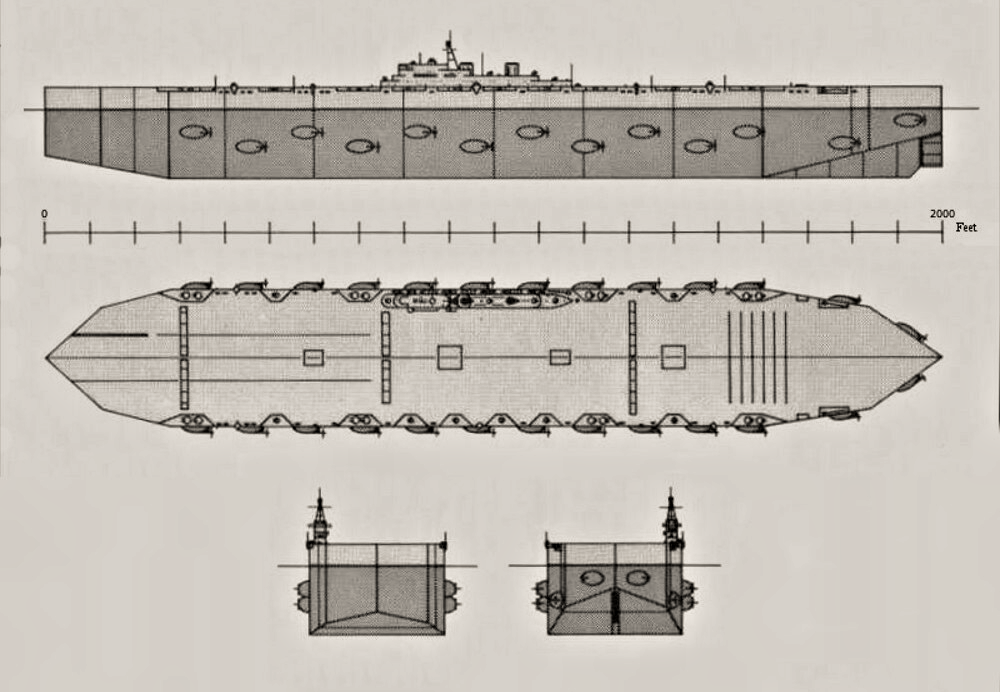Unconventional Tactics
Since the dawn of time, humanity has strived toward innovation in all aspects of technology, including combat. While this may have led to the most deadly armaments in history, it also led to some of the most inefficient, unwieldy, and downright bizarre ones as well.

The Gun Sword
As opposed to the Harmonica, this was much more literal. The concept dates back to the 16th century, and various combinations were created over the years. Combinations ranged from flintlocks to revolvers, and the “sword” end included blades such as daggers, bowie knives, or cutlasses.
 Silverije, CC BY-SA 4.0, Wikimedia Commons
Silverije, CC BY-SA 4.0, Wikimedia Commons
The Flaming Bayonet
The first records of a bayoneted armament come from the 17th century, but those fighting in WWI wanted more. As an added deterrent, a series of M1917’s had small cases of cartridges attached, which fired six bursts of flame—but it’s unclear whether they ever saw combat. Of course, there are other ways to keep the enemy at a distance.
 National Archives and Records Administration, Wikimedia Commons
National Archives and Records Administration, Wikimedia Commons
The Krummlauf
In an almost Looney Tunes fashion, the Krummlauf was a German attachment developed in WWII with a curved barrel and a mounted mirror. It could supposedly be used to fire at the enemy without peeking out of cover, but it wasn’t the tide-turning solution they thought. Still, people needed to be ready if the enemy did close in.
 Der rikkk, CC BY 3.0, Wikimedia Commons
Der rikkk, CC BY 3.0, Wikimedia Commons
Le Petit Protector
It’s not clear when exactly Le Petit Protector was created, but the design is recognized as being from the 19th century. It’s a functional revolver, but small enough to wear as a ring and equally powerful—only strong enough to pierce the side of a tin can. Perhaps it should have become a piece of spy equipment, like a few others on this list.
The Kiss Of Death
Used in the 1960s by the KGB, this device appeared to be nothing more than lipstick. However, hidden inside a lipstick holder, the 4.5 mm device could fire a single round. Naturally, the world of espionage is full of strange equipment.
 Joyofmuseums, CC BY-SA 4.0, Wikimedia Commons
Joyofmuseums, CC BY-SA 4.0, Wikimedia Commons
The Bulgarian Umbrella
Named for its 1978 use on Bulgarian writer Georgi Markov, this looks like a normal umbrella but is secretly able to shoot a poison pellet. Of course, aside from an umbrella, many things can be combined like this.
The Apache Revolver
Named after Les Apaches, the Parisian underworld subculture that invented it in the late 1800s, this item is almost like a Swiss army revolver. It contained a knuckle duster, a small blade, and a short-range revolver.
 Latente Flickr, CC BY-SA 2.0, Wikimedia Commons
Latente Flickr, CC BY-SA 2.0, Wikimedia Commons
The Nest Of Bees
Evolving from the fire arrows used across Asia, the Nest of Bees was named for the barrel’s honeycomb shape and was loaded with rocket- and gunpowder-fitted arrows. This marked an early example in a long line of using rockets to get that edge in battle.
 Germanisches Nationalmuseum, CC BY-SA 4.0, Wikimedia Commons
Germanisches Nationalmuseum, CC BY-SA 4.0, Wikimedia Commons
The Mysorean Rockets
In 18th century India, the Mysorean Rockets were the first iron-cased rockets to be successfully used in battle. Their design was simple, with a small rocket attached to the end of a bamboo shaft, but they were utilized in many battles before eventually being adopted by the British.
 Wellcome Images, Wikimedia Commons
Wellcome Images, Wikimedia Commons
The Great Panjandrum
Somewhere between a battering ram and a bazooka, the Great Panjandrum was developed during WWII to break through the enemy’s barriers. It consisted of an explosive steel drum propelled by two wheels lined with a series of rockets. It was ultimately too uncontrollable—however, the answer to “Can rockets get any bigger?” is always “yes”.
 Imperial War Museums, Wikimedia Commons
Imperial War Museums, Wikimedia Commons
The Davy Crockett
This next item may have been the closest humanity has come to a real handheld nuclear launcher. The Davy Crockett was used between the ‘60s and ‘70s and was a type of launcher that could shoot a W54 warhead, the smallest fission explosive ever deployed in the US.
The Bazooka Vespa
This vehicle was exactly how it sounded. In the 1950s, the French developed the Vespa 150 TAP by attaching an M20 to a Vespa. Although it was intended to be placed upon a tripod before usage, the bazooka could be fired from the moving scooter in emergencies. However, this wasn’t the only bike to pack a punch.
 R.I.V.A.R.S, C.Galliani, CC BY 3.0, Wikimedia Commons
R.I.V.A.R.S, C.Galliani, CC BY 3.0, Wikimedia Commons
The Tsar Tank
Appearing more like a tricycle, the Tsar Tank was a failed Russian creation from 1914. Unlike most tanks that used caterpillar tracks to move, this was mounted onto two large wheels in front, and a smaller wheel for steering in the back. Of course, there have been many more bizarre tank designs in history.
 Unknown Author, Wikimedia Commons
Unknown Author, Wikimedia Commons
Cultivator No 6
During WWII, Winston Churchill envisioned Cultivator No 6 to turn the tide. The armored vehicle would, hypothetically, deliver people to the enemy lines through a trench of its own making. Unfortunately, as Germany’s technology advanced, the Cultivator became obsolete before it even saw combat.
 Imperial War Museums, Wikimedia Commons
Imperial War Museums, Wikimedia Commons
The Baynes Bat
We’ve seen tanks on and in the ground, but what about the skies? For use in WWII, an experimental gliding tank was designed by English engineer L.E. Baynes before the project was abandoned. The basic idea was that wings could be attached to a tank to fly it into a battlefield, airdropping it in. At least, unlike this next project, they didn’t use real bats.
 Red Rooster, Wikimedia Commons
Red Rooster, Wikimedia Commons
Project X-Ray
Again, in WWII, one Dr Lytle S. Adams designed a device that would release thousands of bats into the air. The animals were fitted with timed incendiary explosives, set to ignite after they roosted in the enemy’s buildings. Although the high cost eventually got the project canceled, the history of combat is still riddled with using animal-based equipment.
 United States Army Air Forces, Wikimedia Commons
United States Army Air Forces, Wikimedia Commons
Project Pigeon
In another instance of not-so-subtle naming conventions, Project Pigeon saw an imagined alternative to guided missiles. In WWII, B.F. Skinner had the idea of using trained pigeons to carry missiles and guide them to their targets. Nobody took the project seriously, though, and it was scrapped early on.
 U.K. Ministry of Information, Picryl
U.K. Ministry of Information, Picryl
Explosive Rats
In WWII, the British began using rat carcasses containing small explosives that would detonate upon burning. The first shipment was intercepted by the Germans, who spent so many resources in looking for more, that the project was considered a success. Of course, the rat’s natural predator didn’t fare much better.
 National Media Museum United Kingdom, Picryl
National Media Museum United Kingdom, Picryl
Operation Acoustic Kitty
Returning to the world of espionage, in the 1960s, the CIA surgically implanted both a microphone and radio transmitter into the head of a cat. Its purpose was to covertly listen to foreign officials, but on its first trial run, the cat wandered into the street and was tragically run over.
 National Museum of the U.S. Navy, Picryl
National Museum of the U.S. Navy, Picryl
Anti-Tank Dogs
As a new anti-tank measure, the Russian army in WWII designed a harness that would allow a trained dog to carry a mine under enemy tanks and detonate them. However, the dogs weren’t prepared for actual combat, more often returning to their handlers and blowing them up. However, the fate of the next animal may be the worst of all.
 Unknown Author, Wikimedia Commons
Unknown Author, Wikimedia Commons
Battle Pigs
Sadly, the kind of animal harm seen in WWII is nothing new. Around the time of 200 BC, both Roman and Greek records mention a way of turning back elephants in the form of Battle Pigs. These pigs were set ablaze and aimed at the elephants, who would flee from the squealing, flaming animals.
 The National Archives UK, Wikimedia Commons
The National Archives UK, Wikimedia Commons
The Zhanmadao
Dating back to China’s Han Dynasty—starting in 206 BC—the Zhanmadao was an anti-cavalry sword that loosely translates to “horse chopping saber”. While it was designed specifically to cut through the legs of the enemy’s horses, its earliest variant was allegedly able to decapitate a horse completely.
The Novgorod
After a published article theorized that a ship could strengthen its offense and defense by widening its beam, the Russian Navy ran with it. The Novgorod was built in the 1870s with a completely circular hull, allowing it to have heavier armor and artillery. While believed to be a total failure, it actually succeeded as a coast-defense ship. Still, it’s not the most bizarre battleship.
 Unknown Author, Wikimedia Commons
Unknown Author, Wikimedia Commons
Project Habakkuk
When materials became more expensive during WWII, the British devised Project Habakkuk, an entire aircraft carrier created from a mixture of wood pulp and ice. Unfortunately, before it could leave a mark, it was shelved as it became too expensive as well. With normal battleships, though, more inventive techniques might be required to combat them.
 Unknown Author, Wikimedia Commons
Unknown Author, Wikimedia Commons
The Claw Of Archimedes
Around 200 BC, legendary engineer Archimedes invented a device designed to counterattack invading ships. Used in the siege of Syracuse, Roman ships were met with a series of Claws along the city’s walls, which grabbed hold and capsized them. Of course, humanity’s machines have since evolved from just the land and sea.
 Giulio Parigi, Wikimedia Commons
Giulio Parigi, Wikimedia Commons
The Korabl Maket
In the early 1960s, the Soviet Union designed the Korabl Maket, a ground-effect aircraft designed to fly at a maximum altitude of 10 meters above land or water. Uniquely, though, a wingspan of 123 feet and a length of 302 feet made it the largest aircraft in the world until 1988, gaining it the nickname “The Caspian Sea Monster” before it crashed in 1980.
 Fblockmetal, CC BY-SA 4.0, Wikimedia Commons
Fblockmetal, CC BY-SA 4.0, Wikimedia Commons
The Boeing YAL-1
One of the most recent inventions, the Boeing YAL-1, was actually a Boeing 747-400F that was modified to include a near-infrared laser. It was intended as a system to destroy ballistic missiles, but after funding was cut, the aircraft was scrapped. Now, with such powerful aircraft, certainly someone would create equally innovative inventions to take them down.
 United States Air Force, Kellie Masters, Wikimedia Commons
United States Air Force, Kellie Masters, Wikimedia Commons
The Wind Cannon
The Windkanone (or “Wind Cannon”) was one of Germany’s WWII inventions whose concept featured an enormous barrel that would shoot a concussive blast of compressed air at enemy aircraft. However, it never achieved any substantial results.
The Double-Barreled Cannon
Although the concept originated earlier, John Gilleland’s failed version of the Double-Barreled Cannon appeared in the 1860s. It was meant to fire two chained cannonballs at the same time, but unfortunately, the barrels never synchronized properly.
 Jud McCranie, CC BY-SA 4.0, Wikimedia Commons
Jud McCranie, CC BY-SA 4.0, Wikimedia Commons
The Puckle
Thought by many to be one of the first—if not the first—machine armaments in history, this item was invented by James Puckle in the 1700s. However, instead of automatic, it was more of a tripod-mounted, revolving flintlock musket. Although at least two were produced, it never saw any combat.
 Simon Cousins (Tawcnysc), Wikimedia Commons
Simon Cousins (Tawcnysc), Wikimedia Commons
The Schwerer Gustav
Known as the heaviest mobile piece of artillery in history, the Schwerer Gustav was a railway cannon created by Germany in WWII to break through some of France’s nigh-indestructible forts. Although it saw some use in combat, Germany had it destroyed to avoid it being captured. Still, there are plenty of other bizarrely designed explosive armaments.
 Jan Wellen, CC BY-SA 3.0, Wikimedia Commons
Jan Wellen, CC BY-SA 3.0, Wikimedia Commons
Sticky Grenades
Although they may seem fictional, Sticky Grenades were produced during WWII by the British. The grenade included a container of nitroglycerin covered in birdlime—a strong adhesive—inside a spherical shell with a wooden handle. One pin would release the shell, allowing the grenade to be stuck to a target, while a second pin started the detonator.
 Ministry of Information Photo Division, Bryson Jack, Wikimedia Commons
Ministry of Information Photo Division, Bryson Jack, Wikimedia Commons
The Human Torpedo
Dating back to 1909, the Human Torpedo concept has seen variations from many countries, especially during WWII. The basic idea was a torpedo that seated one or two people and could be piloted manually. Some iterations featured remote detonation, while others had to be driven right into the target. But who says explosives must only be under the water?
 Museum of Science and Technology, CC BY-SA 4.0, Wikimedia Commons
Museum of Science and Technology, CC BY-SA 4.0, Wikimedia Commons
Upkeep
In 1943, the British attempted to destroy a series of German dams but were unable to use any explosives from the air or underwater. As an alternative, they created special cylindrical mines—codenamed Upkeep—that were dropped by jets and successfully skipped on top of the water until they reached the base of each dam.
 Flying Officer Jerry Fray RAF, Wikimedia Commons
Flying Officer Jerry Fray RAF, Wikimedia Commons
The M43
In the 1960s, the US government began experimenting with a new incapacitating agent and created an explosive which dispersed a cloud of the chemical BZ. Intended to be non-lethal, it instead caused mania, paranoia, and self-injury, so it was never widely used.
 Billyhill, CC BY-SA 4.0, Wikimedia Commons
Billyhill, CC BY-SA 4.0, Wikimedia Commons
The Heliobeam
With the potential to burn up a city, the concept of the Sonnengewehr (or “Heliobeam”) was explored by German scientists during WWII. Although theoretical, the idea was that a nine- square-kilometer reflector could be held in orbit, and harness the sun as a destructive force. However, the Germans aren’t the only ones to think of destruction from space.
 Ministry of Information Photo Division, Bryson Jack, Wikimedia Commons
Ministry of Information Photo Division, Bryson Jack, Wikimedia Commons
Rods From God
During the 1950s, a man named Jerry Pournelle came up with the idea of a new kind of massive system for destruction. The idea was that tungsten rods the size of telephone poles could be dropped from orbit with a similar force to a nuclear blast, but without the fallout. At the end of the day, though, some bizarre devices don’t have to be lethal.
 United States Army, Wikimedia Commons
United States Army, Wikimedia Commons
The Millwall Brick
Less of an official part of an arsenal and more of an improvised club, the Millwall Brick was popular in England around the 1960s and ‘70s. For football fans who were prone to hooliganism and wanted to sneak in something to fight with, they would simply stack, fold, and roll several newspapers together into a blunt instrument.
 Majorly, CC BY-SA 3.0, Wikimedia Commons
Majorly, CC BY-SA 3.0, Wikimedia Commons
The Harmonica
As one of the few items on this list to see moderate success, the Harmonica gained a short stint of popularity in the mid-1800s. It didn’t make music, but it looked like a harmonica with its horizontal slide that would feed the ammo through its breech end.
 Amendola90, CC BY-SA 3.0, Wikimedia Commons
Amendola90, CC BY-SA 3.0, Wikimedia Commons
Who Me
Believe it or not, the OSS developed a stink device in WWII for the French resistance. Who Me was created as a small spray bottle that could shoot an extremely smelly, sulfurous chemical onto the Germans as a means to humiliate them. It didn’t last long, however, since it was almost impossible for the user to not end up smelling as well.
















